Short Answers
Q.1. Can we have a single north pole, or a single south pole?
No, we cannot have a single north or south pole. Magnetic poles are always found in pairs. They are equal in strength and opposite in nature. Even if we break a magnet into a number of pieces, each piece will become a magnet with equal and opposite poles.
Q.2. Do two distinct poles actually exist at two nearby points in a magnetic dipole?
No, two distinct poles cannot exist at two nearby points in a magnet, as a magnet contains only two distinct poles located at its ends.
Q.3. An iron needle is attracted to the ends of a bar magnet but not to the middle region of the magnet. Is the material making up the ends of a bare magnet different from that of the middle region?
No, the material making up the middle region of a magnet is the same as that of the material making up its end. When an iron needle is taken closer to one of the ends of a magnet, the pole of the magnet induces a pole of opposite polarity on the needle, making the needle a magnet itself and thereby making it attracted to that pole.
But if we bring the needle closer to the centre of the magnet, then both the poles of the magnet will induce opposite polarity on the needle. As a result, the needle will not get attracted towards the centre of the magnet.
Q.4. Compare the direction of the magnetic field inside a solenoid with that of the field there if the solenoid is replaced by its equivalent combination of north pole and south pole.
The direction of the magnetic field is the same in both cases, that is, inside a solenoid and inside a bar magnet. In a solenoid, magnetic field lines are directed from one end to the other internally and externally, so they are in the equivalent combination of north and south poles (as shown in figure).
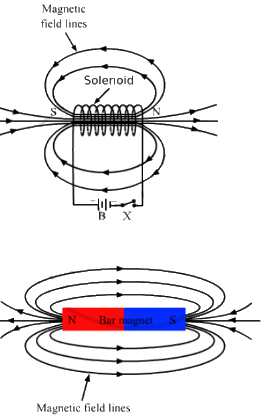
Q.5. Sketch the magnetic field lines for a current-carrying circular loop near its centre. Replace the loop by an equivalent magnetic dipole and sketch the magnetic field lines near the centre of the dipole. Identify the difference.
The difference between the two configurations is that in the current-carrying loop, the magnetic field lines pass through the centre and are perpendicular to its axis; whereas in the equivalent magnetic dipole, the magnetic field lines do not pass through the centre.

Q.6. The force on a north pole,  parallel to the field
parallel to the field  Does it contradict our earlier knowledge that a magnetic field can exert forces only perpendicular to itself?
Does it contradict our earlier knowledge that a magnetic field can exert forces only perpendicular to itself?
Yes, it seems to contradict with our earlier knowledge that a magnetic field can exert forces only perpendicular to itself.

here ,
 = Magnetic field
= Magnetic field
m = Magnetic charge
For a positive magnetic charge, force is along the magnetic field.
For a negative magnetic charge, force is opposite to the magnetic field.
Thus, it contradicts the notion that a magnetic field can exert forces only perpendicular to itself.
Q.7. Two bar magnets are placed close to each other with their opposite poles facing each other. In absence of other forces, the magnets are pulled towards each other and their kinetic energy increases. Does it contradict our earlier knowledge that magnetic forces cannot do any work and hence cannot increase kinetic energy of a system?
Yes, it contradicts our earlier knowledge that magnetic forces cannot do any work and hence cannot increase the kinetic energy of the system. When opposite poles are facing each other, an attractive force acts between them so the magnets are pulled towards each other. As the two magnets come close to each other so the force between them increases and hence, the kinetic energy also increases.
Q.8. Magnetic scalar potential is defined as 
Apply this equation to a closed curve enclosing a long straight wire. The RHS of the above equation is then  by Ampere's law. We see that
by Ampere's law. We see that  even when
even when  Can we have a magnetic scalar potential in this case?
Can we have a magnetic scalar potential in this case?
No, we cannot have a magnetic scalar potential here.
Ampere's law is a method of calculating magnetic field due to current distribution. On the other hand, magnetic scalar potential requires a magnetic field due to pole strength m.
Potential at a distance r is given by 
As there is no current distribution, no magnetic field due to poles or the pole strength is present. That is why we cannot have a magnetic scalar potential in this case.
Q.9. Can the earth's magnetic field be vertical at a place? What will happen to a freely suspended magnet at such a place? What is the value of dip here?
Yes, Earth's magnetic field is vertical at the poles. A freely suspended magnet becomes vertical at the poles, with its north pole pointing towards Earth's north pole, which is magnetic south.
The value of the angle of the dip here is 90°.
Q.10. Can the dip at a place be (a) zero (b) 90°?
(a) Yes, the dip can be zero at the equator of Earth.
(b) Yes, the dip can be 90° at the poles of Earth.
Q.11. The reduction factor K of a tangent galvanometer is written on the instrument. The manual says that the current is obtained by multiplying this factor to tan θ. The procedure works well at Bhuwaneshwar. Will the procedure work if the instrument is taken to Nepal? If there is same error, can it be corrected by correcting the manual or the instrument will have to be taken back to the factory?
Yes, the procedure will work if the instrument is taken to Nepal, as the current at a place can be calculated by multiplying the reduction factor K with tan θ of that place . In our case, we will take the value of tan θ of Nepal, as tan θ may vary from place to place. tan θ at any place is determined from the mathematical formula B/BH, where B is the external magnetic field and BH is the horizontal component of Earth's magnetic field Thus, we need not take the manual or the instrument back to the factory for correction.
Multiple Choice Questions
Question for HC Verma Questions and Solutions: Chapter 36: Permanent Magnets- 1
Try yourself:A circular loop carrying a current is replaced by an equivalent magnetic dipole. A point on the axis of the loop is in
Explanation
Points lying on the axis of a magnet are called end-on points. In our case, the point on the axis of the loop (on replacing the circular loop with an equivalent magnetic dipole) lies on the axis of the magnetic dipole or on the end-on position.
If P was the point on the axis of the loop, then it is clear from the figure that P lies on the end-on position of the equivalent magnetic dipole.
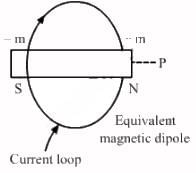
Report a problem
Question for HC Verma Questions and Solutions: Chapter 36: Permanent Magnets- 1
Try yourself:A circular loop carrying a current is replaced by an equivalent magnetic dipole. A point on the loop is in ______.
Explanation
A circular loop carrying a current is replaced by an equivalent magnetic dipole. A point on the loop is in end-on position.
Report a problem
Question for HC Verma Questions and Solutions: Chapter 36: Permanent Magnets- 1
Try yourself:When a current in a circular loop is equivalently replaced by a magnetic dipole,
Explanation
When we replace a circular current-carrying loop with a magnetic dipole to resemble field lines of the circular loop, the pole strength m and the distance between the poles are not fixed.
But the magnetic dipole moment of both systems is always fixed. It is the product of the magnetic moment and the distance between the poles. In other words, md is fixed.
A current loop of area A and current I can be replaced with a magnetic dipole of dipole moment md.
i.e. md = IA
Report a problem
Question for HC Verma Questions and Solutions: Chapter 36: Permanent Magnets- 1
Try yourself:Let r be the distance of a point on the axis of a bar magnet from its centre. The magnetic field at such a point is proportional to
Explanation
Magnetic field B due to a bar magnet of magnetic moment M at distance r of the point on the axis of the magnet from its centre is given by

Here, 2l is the length of the magnet.
So, from the above formula, it can be easily seen that 
Report a problem
Question for HC Verma Questions and Solutions: Chapter 36: Permanent Magnets- 1
Try yourself:Let r be the distance of a point on the axis of a magnetic dipole from its centre. The magnetic field at such a point is proportional to
Explanation
Magnetic field B due to a bar magnet of magnetic moment M at distance r of the point on the axis from its centre is given by 
Here, 2l is the length of the magnet.
When the distance of the point where the magnetic field has to be calculated is greater than the length of the magnet, i.e r >> l , the bar magnet acts like a magnetic dipole whose magnetic field is B ∝ (1/r3)
Now, l in the denominator can be neglected.
So, the correct option is (c).
Report a problem
Question for HC Verma Questions and Solutions: Chapter 36: Permanent Magnets- 1
Try yourself:Two short magnets of equal dipole moments M are fastened perpendicularly at their centre in the Figure . The magnitude of the magnetic field at a distance d from the centre on the bisector of the right angle is
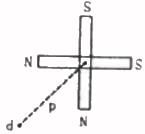
Explanation
Report a problem
Question for HC Verma Questions and Solutions: Chapter 36: Permanent Magnets- 1
Try yourself:Magnetic meridian is
Explanation
Magnetic meridian at a place is not a line but a vertical plane passing through the axis of a freely suspended magnet.
Report a problem
Question for HC Verma Questions and Solutions: Chapter 36: Permanent Magnets- 1
Try yourself:A compass needle which is allowed to move in a horizontal plane is taken to a geomagnetic pole. It ______.
Explanation
When taken to a geomagnetic pole, a compass needle that is allowed to move in a horizontal plane will try to suspend itself vertically to the horizontal plane containing the compass. In other words, the horizontal plane containing the compass will restrict the compass to suspend itself in vertical direction; hence, the compass will stay in any position.
However, a freely suspended magnet will become vertical at poles, with its north pole pointing towards Earth at its north pole (which is magnetic south).
Report a problem
Question for HC Verma Questions and Solutions: Chapter 36: Permanent Magnets- 1
Try yourself:A dip circle is taken to geomagnetic equator. The needle is allowed to move in a vertical plane perpendicular to the magnetic meridian. The needle will stay ______.
Explanation
At the geomagnetic equator, the needle tries to suspend itself in horizontal direction. But here the needle is restricted to move only in the vertical plane perpendicular to the magnetic meridian. Hence, the needle will stay in the direction it is released.
Report a problem
Question for HC Verma Questions and Solutions: Chapter 36: Permanent Magnets- 1
Try yourself:A tangent galvanometer is connected directly to an ideal battery. If the number of turns in the coil is doubled the deflection will
Explanation
For a tangent galvanometer, deflection is given by

Here, k is the constant called reduction factor.
From the above formula, we can say that deflection is independent of the number of turns.
Hence, on doubling the number of turns, deflection remains the same.
Report a problem
Question for HC Verma Questions and Solutions: Chapter 36: Permanent Magnets- 1
Try yourself:If the current is doubled, the deflection is also doubled in
Explanation
The current and deflection dependence of a moving coil galvanometer is given by 
Therefore, if we double the current, the deflection also gets doubled.
However, in a tangent galvanometer, i ∝ tan θ; that is, there is no direct relation between θ and current.
Hence, the correct option is (b).
Report a problem
Question for HC Verma Questions and Solutions: Chapter 36: Permanent Magnets- 1
Try yourself:A very long bar magnet is placed with its north pole coinciding with the centre of a circular loop carrying as electric current i. The magnetic field due to the magnet at a point on the periphery of the wire is B. The radius of the loop is a. The force on the wire is
Explanation
Report a problem
*Multiple options can be correct
Question for HC Verma Questions and Solutions: Chapter 36: Permanent Magnets- 1
Try yourself:Pick the correct options.
Explanation
Investigators and experimenters have failed to find any sign of magnetic monopoles. So, we can assume that magnetic monopoles are only a mathematical assumption.
A magnetic field is produced by the motion of an electric charge only. In paramagnets or ferromagnets, the motion of an electron (charge) and the alignment of domains (bunch of charges with particular alignment) create paramagnetism and ferromagnetism, respectively.
Therefore, the only cause behind the magnetic field is the motion of an electric charge.
Denial of (c):
The north pole is equivalent to an anticlockwise current and the south pole is equivalent to a clockwise current.
Denial of (d):
A bar magnet is not equivalent to a long, straight current because the distribution and orientation of magnetic field lines do not resemble each other.
*Multiple options can be correct
Question for HC Verma Questions and Solutions: Chapter 36: Permanent Magnets- 1
Try yourself:A horizontal circular loop carries a current that looks clockwise when viewed from above. It is replaced by an equivalent magnetic dipole consisting of a south pole S and a north pole N.
Explanation
A horizontal circular loop carrying current in clockwise direction acts like the south pole of a magnet. Hence, the south pole of the magnet coincides with the loop.
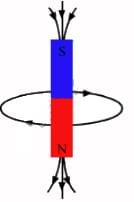
Now, when the loop carrying current in clockwise direction is viewed from above, it looks like the magnetic lines of force are entering the loop thus it acts like south pole of a magnet. And if we view from below the loop then it appears that magnetic lines of force are leaving the loop. Hence, the north pole should be below the loop.
*Multiple options can be correct
Question for HC Verma Questions and Solutions: Chapter 36: Permanent Magnets- 1
Try yourself:Consider a magnetic dipole kept in the north to south direction. Let P1, P2, Q1, Q2 be four points at the same distance from the dipole towards north, south, east and west of the dipole respectively. The directions of the magnetic field due to the dipole are the same at
Explanation
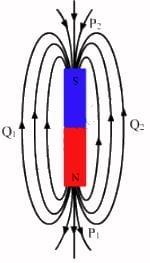
We know that magnetic field lines are directed from the north pole to the south pole. From the given figure, we can say that the direction of magnetic field  is the same only at points P1 and P2 and at points Q1 and Q2.
is the same only at points P1 and P2 and at points Q1 and Q2.
*Multiple options can be correct
Question for HC Verma Questions and Solutions: Chapter 36: Permanent Magnets- 1
Try yourself:Consider the situation of the previous problem. The directions of the magnetic field due to the dipole are opposite at
Explanation
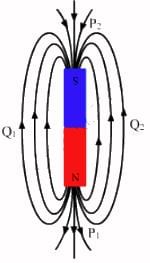
We know that magnetic field lines are directed from the north pole to the south pole. From the given figure, we can say that the direction of the magnetic field  is opposite at points P1 and Q1 and at points P2 and Q2.
is opposite at points P1 and Q1 and at points P2 and Q2.
*Multiple options can be correct
Question for HC Verma Questions and Solutions: Chapter 36: Permanent Magnets- 1
Try yourself:To measure the magnetic moment of a bar magnet, one may use
Explanation
Denial of (a):
Tangent galvanometer is an instrument used to measure electric current; it cannot be used to the measure magnetic moment of a bar magnet.
Justification of (b) and (c) :
Deflection magnetometer is used to measure M/BH of a permanent bar magnet.
Similarly, oscillation magnetometer is used to measure MBH of a bar magnet. So, if earth's horizontal field, BH is known, then the magnetic moment of a bar magnet, M, can be measured.
Justification of (d):
Using deflection and oscillation magnetometers, we can calculate  respectively . Therefore, if we multiply the result obtained from both the instruments, then BH cancels out as
respectively . Therefore, if we multiply the result obtained from both the instruments, then BH cancels out as  Thus, the value of BH is not required.
Thus, the value of BH is not required.
Therefore, we can use both deflection and oscillation magnetometers if the earth's horizontal field is not known.
 parallel to the field
parallel to the field  Does it contradict our earlier knowledge that a magnetic field can exert forces only perpendicular to itself?
Does it contradict our earlier knowledge that a magnetic field can exert forces only perpendicular to itself?= Magnetic field

 by Ampere's law. We see that
by Ampere's law. We see that  even when
even when  Can we have a magnetic scalar potential in this case?
Can we have a magnetic scalar potential in this case?
















 ...(1)
...(1) ...(2)
...(2)


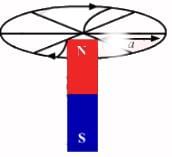

 and it is perpendicular to the plane of the wire.
and it is perpendicular to the plane of the wire.

 is the same only at points P1 and P2 and at points Q1 and Q2.
is the same only at points P1 and P2 and at points Q1 and Q2.
 is opposite at points P1 and Q1 and at points P2 and Q2.
is opposite at points P1 and Q1 and at points P2 and Q2. respectively . Therefore, if we multiply the result obtained from both the instruments, then BH cancels out as
respectively . Therefore, if we multiply the result obtained from both the instruments, then BH cancels out as  Thus, the value of BH is not required.
Thus, the value of BH is not required.














